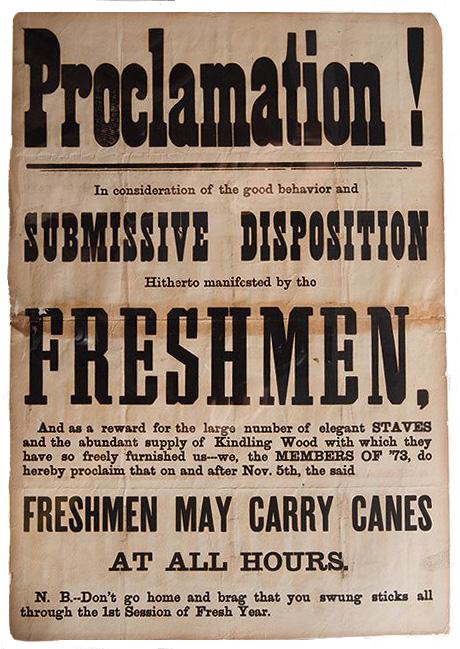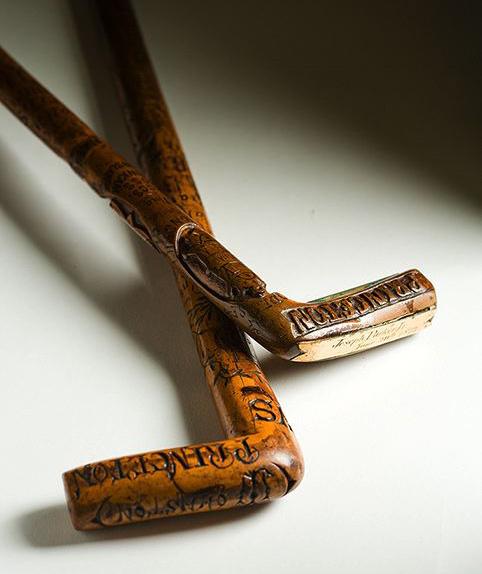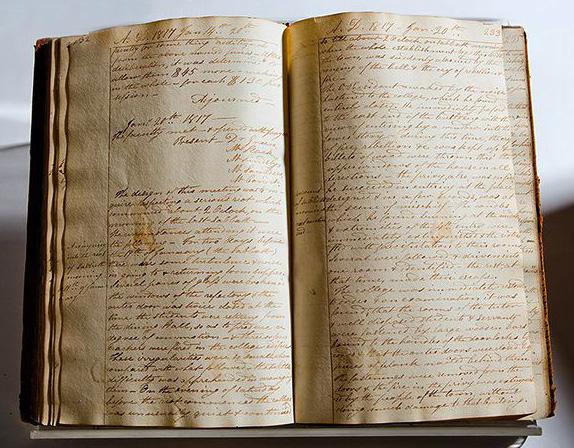

19th-century dorm life: Lacking the now-standard bed, dresser, and desk, undergraduate dormitory rooms in the 19th century still could be personalized and comfortably furnished, as illustrated by this pencil sketch made by George Van Wagenen 1868. Van Wagenen, who shared this room in East College with his brother and classmate, Edward, appears to have had a suite, as the one item of furniture missing is a bed. East College, built in 1834, was the first campus dormitory. It stood on the east side of Cannon Green, directly opposite West College. Together with Nassau Hall to the north and Whig and Clio halls to the south, the buildings “helped to form a quadrangle of pleasing symmetry,” in the words of A Princeton Companion. East College was demolished in 1896 (to make way for what is now East Pyne), much to the consternation of many of its old residents, who decried the “Crime of Ninety-Six.”

Sophomore proclamation, 1869: Freshman hazing was long a feature of college life and sophomores, having just been released from torment, were determined to do to the new freshmen what had just been done to them. In the years just after the Civil War, when walking sticks were an essential item of a gentleman’s attire, sophomores declared a rule banning freshmen from carrying them, lest they put on airs. Any freshman caught with a contraband cane was liable to be jumped, the cane taken away by force and reduced to “elegant staves” or “kindling wood.” In this proclamation from 1869, the sophomore class announced that because of the freshmen’s “submissive disposition,” the ban would be lifted. Over time, the freshmen and sophomores designated representatives to fight it out for class supremacy. This and other forms of hazing later were banned, but a vestige remains in the annual Cane Spree.

Upperclass canes: These are two examples of the elegantly carved canes carried by student dandies during the Gilded Age. Students would engrave the canes themselves with their names, class years, the University crest, the names of friends or favorite faculty members, or Greek phrases. These two particular canes belonged to Tobias Walter Johnston 1872, a Mississippi native who spoke at his Commencement exercises on “Suggestions of the Past,” and Joseph Parker Jr. 1874.

Woodrow Wilson’s autograph book: College yearbooks did not become common until the beginning of the 20th century. Before that time, students bought autograph books and asked friends to sign them. This book, belonging to Francis (“Frank”) Garmany 1879, who was from Savannah, Ga., bears a heartfelt inscription from his classmate, Woodrow Wilson. Born in Virginia and raised in Georgia, Wilson was one of fewer than two dozen Southerners in his class but was always conscious of his regional background. Although he presented an austere front to the world, Wilson actively participated in campus activities as a student and believed that his true passionate nature was often misunderstood. Here he expresses regret that “I, perhaps, am colder and more reserved than most of those who are fortunate enough to have been born in our beloved South.”

Student riot, 1817: For much of Princeton’s first 150 years, relations between faculty and undergraduates were terrible. One of the worst moments came in 1817, part of a period that Thomas Wertenbaker, in his book, Princeton1746-1896, dubs “Princeton’s nadir.” On Sunday, Jan. 19, a group of students, who thought their reading assignments were too long, boarded up the doors to Nassau Hall and trapped many of their more religious classmates in their rooms by nailing their doors shut. They then rang the bell and ran up and down the halls shouting, “Fire!” and “Rebellion.” When administrators tried to break out the windows so students could escape, the perpetrators attacked them, then fled. Because no one confessed, President Ashbel Green dismissed at least 14 students “without formal proof,” which sparked its own riot in which Nassau Hall was occupied, Prayer Hall partly destroyed, and Green himself pelted with ice. Some of the details of the infamous 1817 riot are detailed here in the trustees’ minutes.

